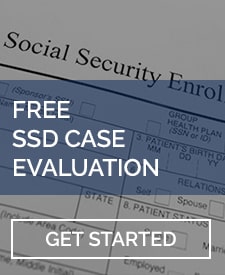Introduction
Scleroderma, or crest syndrome, is a rare, chronic autoimmune disorder. It’s marked by the hardening and tightening of skin and connective tissues. This condition mostly affects females, presenting unique challenges in both diagnosis and treatment.
The impact of scleroderma extends beyond physical symptoms. It often affects quality of life and the ability to work. For individuals living with this condition, understanding its implications is crucial. This includes navigating disability benefits and seeking legal support.
Recognizing scleroderma’s role in disability eligibility is vital. It helps in securing the necessary support and accommodations. Our focus is to shed light on these aspects, aiding those affected in their journey.
What is Scleroderma?
Scleroderma, a condition marked by an abnormal immune response, leads to the hardening and thickening of the skin and connective tissues. It often presents a complex case for diagnosis due to its varied effects on different body parts. Typically manifesting between ages 30 and 50, scleroderma disability affects an estimated 40,000 to 165,000 people in the U.S. The unique nature of scleroderma disability makes it a significant concern for those it affects.
To gain a deeper understanding of scleroderma, including its symptoms and causes, visit the National Institute of Arthritis and Musculoskeletal and Skin Diseases (NIAMS) comprehensive resource on scleroderma.
Diagnosis and Effects of Scleroderma Disability
Diagnosing scleroderma involves a thorough physical examination and a series of blood tests. The condition leads to degenerative changes and scarring in the skin, joints, and internal organs, often complicating the approach to treatment. Understanding these effects is crucial in managing scleroderma disability, as the severity and spread of the condition can vary greatly from one individual to another.
The Impact of Scleroderma Disability on Individuals
Individuals with scleroderma disability face various challenges. The condition’s progression can lead to significant physical limitations and impact daily activities. This underscores the importance of early and accurate diagnosis for effective management of scleroderma disability.
Living with Scleroderma Disability
Living with scleroderma disability requires adapting to various symptoms and complications. The condition can limit mobility, affect organ function, and significantly impact an individual’s quality of life. Support and understanding from healthcare providers are essential in navigating the complexities of scleroderma disability.
| Aspect | Details |
|---|---|
| Symptoms | Hardening of skin, joint pain, limited mobility |
| Diagnosis | Physical exam, blood tests |
| Treatment Options | Medications, physical therapy, targeted therapies |
| Daily Life Challenges | Mobility issues, adapting to symptoms |
| Mental Health Support | Counseling, therapy, support groups |
| Navigating Healthcare | Understanding insurance, patient advocacy |
| Workplace Accommodations | Modified schedules, ergonomic adjustments |
| Legal Rights | Disability benefits, anti-discrimination laws |
| Technological Innovations | Telemedicine, digital health tools |
| Future Prospects | Ongoing research, new therapies |
Scleroderma Disability and Mental Health

Living with scleroderma disability often entails more than just physical challenges; it can profoundly impact mental health. Individuals may experience heightened levels of stress, anxiety, and depression as they navigate the complexities of the condition. The emotional burden of coping with chronic pain, physical limitations, and the uncertainty of disease progression can be overwhelming.
Mental health support is a critical aspect of comprehensive care for scleroderma disability. Counseling and therapy can provide essential tools for managing stress and emotional turmoil. These services offer a safe space for individuals to express their fears, frustrations, and feelings, helping them develop coping strategies to deal with the psychological aspects of living with a chronic condition.
Support groups, either in-person or online, can also play a significant role. They offer a sense of community and understanding, allowing individuals to share experiences and learn from others who are facing similar challenges.
Scleroderma Disability: Beyond Physical Symptoms
The impact of scleroderma disability goes beyond physical symptoms. It can lead to emotional and psychological challenges, as individuals adjust to life with a chronic condition. Access to comprehensive care and support services is vital for those living with scleroderma disability.
| Life Aspect | Impact of Scleroderma Disability | Supportive Measures |
|---|---|---|
| Personal Life | Daily routine adjustments, physical limitations. | Rehabilitation, lifestyle modifications. |
| Workplace | Need for accommodations, potential career impact. | Legal rights awareness, employer negotiations. |
| Mental Health | Stress, anxiety, depression risks. | Counseling, therapy, support groups. |
| Social Interactions | Challenges in social activities, maintaining relationships. | Community support, social skills training. |
| Healthcare Navigation | Difficulty accessing specialized care, insurance complexities. | Patient advocacy, healthcare literacy. |
| Legal Rights | Navigating disability benefits, anti-discrimination protection. | Legal counsel, advocacy groups. |
| Physical Activity | Limited mobility, exercise challenges. | Physiotherapy, adapted fitness programs. |
| Diet and Nutrition | Dietary needs due to symptoms. | Nutritional counseling, personalized diet plans. |
| Emotional Well-being | Coping with chronic illness, emotional adjustments. | Psychological support, mindfulness practices. |
| Future Planning | Uncertainty about disease progression, life planning. | Counseling, financial and legal planning assistance. |
Navigating the Healthcare System

Navigating the healthcare system with scleroderma disability requires an understanding of various components, including insurance policies and coverage options. Patients often face challenges in obtaining approval for treatments, medications, and specialized care. Advocating for patient rights becomes a critical skill in these scenarios.
Navigating the bureaucracy of healthcare systems and insurance can be daunting. However, there are resources available, such as patient advocates and social workers, who can assist in understanding and accessing the necessary care. Additionally, being well-informed about the condition and available treatments can empower patients to have more productive discussions with healthcare providers.
Scleroderma Disability in the Workplace
Maintaining employment while managing scleroderma disability can be a significant challenge. The fluctuating nature of the condition can impact an individual’s ability to perform certain tasks. Understanding and accessing workplace accommodations is crucial. Employers are often required by law to provide reasonable accommodations to employees with disabilities, which may include modified work schedules, ergonomic office equipment, or the ability to work from home.
Educating oneself about disability rights in the workplace is essential. This knowledge helps in negotiating necessary accommodations and ensures protection against discrimination. Resources like disability rights organizations and legal counselors specializing in employment law can provide guidance and assistance.
Legal Rights and Advocacy
Individuals with scleroderma disability must be aware of their legal rights, especially concerning disability benefits and anti-discrimination laws. Navigating the legal system to access these benefits, however, can be complex and requires a thorough understanding of the law.
Seeking legal assistance can be invaluable in these situations. Social Security Disability Lawyers or legal aid organizations can offer guidance on how to apply for disability benefits, appeal denials, and ensure that all legal rights are being upheld. Advocacy extends beyond personal benefit, as it also contributes to broader awareness and understanding of scleroderma disability, potentially influencing policy and societal perceptions.
For detailed information on how scleroderma is evaluated for Social Security Disability benefits, refer to the United States Social Security Administration’s guidelines.
Advancements in Managing Scleroderma Disability
Innovative Research and Developments
Recent advancements in medical research have significantly enhanced our understanding of scleroderma disability. These breakthroughs are pivotal in developing more effective treatment strategies. As researchers delve deeper into the underlying mechanisms of scleroderma disability, they are uncovering new ways to manage the condition more effectively. This progress is a beacon of hope for those struggling with the challenges of scleroderma disability.
Targeted Therapies for Scleroderma Disability
One of the key advancements in managing scleroderma disability is the development of targeted therapies. These treatments focus specifically on the processes that drive the progression of scleroderma disability, such as the overactive immune response and the resulting tissue fibrosis. By honing in on these critical factors, medical professionals can provide more personalized and effective care for individuals with scleroderma disability.
Improving Quality of Life
The advancements in treating scleroderma disability are not just about managing symptoms; they are also about improving the overall quality of life for patients. New treatment protocols and medications are being developed to reduce pain, increase mobility, and enhance the daily living experience of those with scleroderma disability. These improvements are crucial in helping individuals lead more comfortable and fulfilling lives despite their condition.
Technological Innovations in Treatment
Technological innovations also play a significant role in the management of scleroderma disability. For instance, telemedicine and digital health tools are becoming increasingly important in monitoring and managing the condition, especially for those who have limited access to specialist care. These technologies make it easier for patients to stay connected with their healthcare providers and receive timely interventions for scleroderma disability.
Future Prospects in Scleroderma Disability Management
Looking to the future, the prospects for managing scleroderma disability are promising. Ongoing research is continually shedding light on new aspects of the condition, paving the way for novel treatments and therapies. The commitment of the medical community to understanding and combating scleroderma disability is stronger than ever, offering hope for even more effective management strategies in the years to come.
| Advancement Category | Description |
|---|---|
| Targeted Therapies | Treatments focusing on specific processes driving scleroderma, such as immune response and tissue fibrosis. |
| Pain Management | New medications and protocols to alleviate chronic pain associated with scleroderma. |
| Mobility Enhancement | Therapies and exercises designed to improve mobility and reduce stiffness. |
| Mental Health Support Innovations | Digital tools and teletherapy options for mental health support. |
| Telemedicine | Remote monitoring and consultations, enhancing access to specialist care. |
| Digital Health Tools | Apps and devices for symptom tracking and management. |
| Research Breakthroughs | Ongoing studies exploring the underlying mechanisms of scleroderma and potential new treatments. |
| Clinical Trials | Latest trials testing new drugs and treatment methods for scleroderma. |
| Community and Advocacy | Growing online communities and advocacy groups providing support and information. |
| Future Therapies | Potential future treatments emerging from current research, offering hope for more effective management. |
Explore comprehensive medical research on scleroderma, including its management and treatment, at the NCBI Bookshelf.
Conclusion
Confronting scleroderma disability requires resilience, awareness, and a multifaceted approach. This condition, while challenging, is becoming increasingly manageable thanks to medical advancements, legal support, and community engagement. The journey of living with scleroderma disability is unique for each individual, marked by both obstacles and opportunities for growth.
The evolving landscape of treatment and care, underscored by innovative research and targeted therapies, is transforming the outlook for those affected. These medical advancements, coupled with the increasing availability of digital health tools, promise a future where managing scleroderma disability is more effective and personalized.
Equally important is the role of mental health support, legal advocacy, and workplace accommodations in ensuring a holistic approach to living with this condition. By understanding and utilizing these resources, individuals with scleroderma disability can not only navigate the complexities of their condition but also thrive despite them.
As we look ahead, the ongoing commitment of healthcare professionals, researchers, legal experts, and support communities to understanding and addressing scleroderma disability continues to inspire hope. It reinforces the belief that despite the challenges, a fulfilling and empowered life is possible for those living with scleroderma disability.
In this journey, the collective efforts in medical, legal, and social domains are pivotal in paving a path towards a more inclusive and understanding society, where the nuances of living with a chronic condition like scleroderma disability are acknowledged and supported.
What Causes Scleroderma Disability?
Scleroderma disability is caused by an autoimmune reaction leading to skin and tissue fibrosis. Its exact cause is unknown, but genetic and environmental factors may contribute.
How Is Scleroderma Disability Diagnosed?
Diagnosis of scleroderma disability involves a physical examination, blood tests to detect specific antibodies, and sometimes skin biopsies to confirm tissue changes.
Can Scleroderma Disability Affect Mental Health?
Yes, scleroderma disability can significantly impact mental health, leading to stress, anxiety, and depression due to chronic pain and lifestyle changes.
Are There Legal Rights for Scleroderma Disability?
Individuals with scleroderma disability have legal rights, including eligibility for disability benefits and workplace accommodations under anti-discrimination laws.




